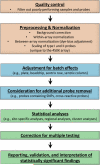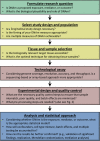The Role of DNA Methylation in Cardiovascular Risk and Disease: Methodological Aspects, Study Design, and Data Analysis for Epidemiological Studies
- PMID: 26837743
- PMCID: PMC4743554
- DOI: 10.1161/CIRCRESAHA.115.305206
The Role of DNA Methylation in Cardiovascular Risk and Disease: Methodological Aspects, Study Design, and Data Analysis for Epidemiological Studies
Erratum in
-
Correction.Circ Res. 2016 Feb 5;118(3):e30. doi: 10.1161/RES.0000000000000094. Circ Res. 2016. PMID: 26846646 No abstract available.
Abstract
Epidemiological studies have demonstrated that genetic, environmental, behavioral, and clinical factors contribute to cardiovascular disease development. How these risk factors interact at the cellular level to cause cardiovascular disease is not well known. Epigenetic epidemiology enables researchers to explore critical links between genomic coding, modifiable exposures, and manifestation of disease phenotype. One epigenetic link, DNA methylation, is potentially an important mechanism underlying these associations. In the past decade, there has been a significant increase in the number of epidemiological studies investigating cardiovascular risk factors and outcomes in relation to DNA methylation, but many gaps remain in our understanding of the underlying cause and biological implications. In this review, we provide a brief overview of the biology and mechanisms of DNA methylation and its role in cardiovascular disease. In addition, we summarize the current evidence base in epigenetic epidemiology studies relevant to cardiovascular health and disease and discuss the limitations, challenges, and future directions of the field. Finally, we provide guidelines for well-designed epigenetic epidemiology studies, with particular focus on methodological aspects, study design, and analytical challenges.
Keywords: 5-methylcytosine; DNA methylation; cardiovascular diseases; epidemiology; risk factors.
© 2016 American Heart Association, Inc.
Figures




References
-
- Jaenisch R, Bird A. Epigenetic regulation of gene expression: How the genome integrates intrinsic and environmental signals. Nat Genet. 2003;33(Suppl):245–254. - PubMed
Publication types
MeSH terms
Grants and funding
- R21 ES020984/ES/NIEHS NIH HHS/United States
- R01 ES020836/ES/NIEHS NIH HHS/United States
- R01 ES021357/ES/NIEHS NIH HHS/United States
- P30 ES000002/ES/NIEHS NIH HHS/United States
- R01 ES021733/ES/NIEHS NIH HHS/United States
- R01ES02083603/ES/NIEHS NIH HHS/United States
- R21ES020984/ES/NIEHS NIH HHS/United States
- P30ES000002/ES/NIEHS NIH HHS/United States
- R01NR013945/NR/NINR NIH HHS/United States
- R01ES021357/ES/NIEHS NIH HHS/United States
- R01ES021733/ES/NIEHS NIH HHS/United States
- R01 NR013945/NR/NINR NIH HHS/United States
LinkOut - more resources
Full Text Sources
Other Literature Sources
Medical
Miscellaneous

